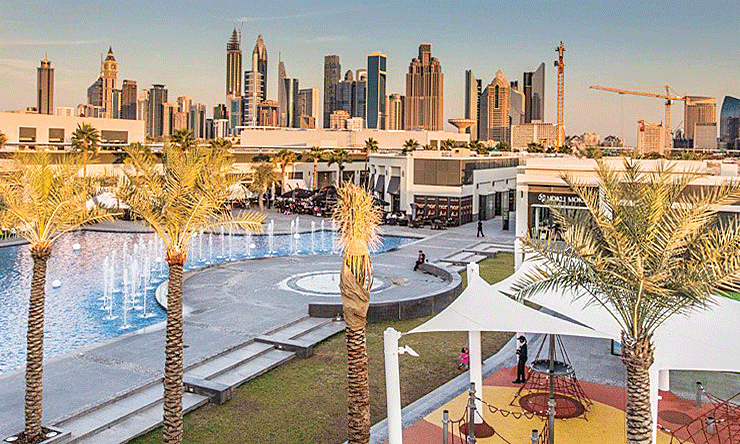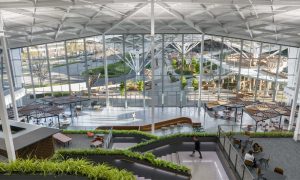The mixed-use boom in the Middle East
How one-stop-destination developments are redefining the landscape

Over the last decade, mixed-use developments have moved to centre stage in urban planning, redefining the real estate landscape in the Middle East.
One-stop-destination developments have mushroomed over every major city, bringing daily essentials like residential, hospitality, office space and retail all within a single address.
“You’re looking at it as a place where the entire family can come spend time,” says Michael Connor, associate director at Faithful + Gould. “So you need a space where you can do shopping, where there are restaurants, casual entertainment, hospitality, maybe even a fine dining experience. Basically, you are looking at capturing the consumer so that the entire family can come down and maximise their time and experience.”
Another factor driving the increase in mixed-use developments is “the requirement to build new districts in a city”, says Dean McGrail, director of Property and Building at WSP | Parsons Brinckerhoff. “The Middle East has taken cues from around the world that when you want to keep an area vibrant throughout the week, 365 days a year, you have to have a development that does that. In the Middle East, you’re building more and more cities and towns, so you need to bring a lot more revenue into every area.”
But the mixed-use concept, especially in the UAE, is by no means a recent phenomenon. “The idea of a mixed-use project is quite old,” notes Isam Ababneh, director of Projects at Union Properties. “Since 2004, the concept of having building communities has become popular. If you look at Abu Dhabi or Dubai, all of those buildings have a couple of retail shops downstairs and residential units upstairs, so they can be considered as very basic mixed-use projects. Nowadays, you have larger developments like Motor City, which has villas, a few buildings, a couple of retail units, etc – all these feature create a complete community so that the person does not have to go outside for anything, be it dining or shopping.”
Over the last few years, a large number of mixed-use developments have been made a part of urban planning with their added value over standard single-use developments steering demand. Developers say one of the biggest advantages of a mixed-use project is the diversity of risk, which gets distributed over four elements – residential, hospitality, retail and office – ensuring that investments are spread out and developers are safeguarded.
Studying market demand to identify what mix works best in an area is crucial to the success of a mixed-use development. One key element for nearly all mixed-use properties in the Middle East is retail, according to McGrail. “The mall becomes the focal point of any development nowadays, and around that mall you would have residential use, office space and maybe villa type of accommodation. It’s really developers and building owners looking to cut down on the transit time. If you look at the Marina, for example, you can go to the Marina Mall to shop and at the same time you could be going to the office and be living close by as well, so that’s really cutting down on commute time and making everything accessible.”
While the synergy of complementary uses may increase cash flow, securing steady revenues also largely depends on managing the facility and operations over the long run. Identifying key performance indicators, establishing performance management systems and balancing cost against quality is essential, especially in large mixed-use properties.
“From an operational cost point of view, the main thing would be setting a service charge,” notes Chris Bond, director of Consultancy at Mace Macro. “There are two things to keep in mind while doing this. First is what the market will bear, and the other is what is required to maintain the development to the standard needed for it to be fully functional for its design life. Now this could involve things like value engineering, when you’re looking at what the market will bear and what’s required,” he explains.
“Another factor is setting a realistic base for operational costs. For example, when we’re talking to clients, we want to get a good understanding of what their objectives are and what their service quality is and then manage that expectation. So if they’re looking for very high quality, they have to understand that that will cost them a lot more. When we do the design models, it’s typically more than what they’re expecting.”
There are a number of ways of keeping operational costs in check, says Bond. “You need to opt for things like multi-skilling. For example, if you use security staff or resources to identify issues in the building and then report it back, you can keep operational costs down for a mixed-use development. You can also look at reducing the number of contracts you have, so for example, instead of having separate facilities management contracts for retail, residential and commercial, perhaps you can get a single company to do all of that.”
Sticking to a budget goes a long way as well with mixed-use projects. As Connor points out, “The budget’s got to be managed very carefully. You have to establish what the cost centres of your development are going to be and then control cost expenditure within that. Expect that there may be change, so that budget has to have an element of contingency, and there has to be robust change management so that that contingency is accessed for justifiable reasons.”
“At WSP | Parsons Brinckerhoff there’s a team that goes and looks at different areas of the design that could potentially be reduced to get the project back on budget,” says McGrail. “That’s a very intricate and consulted process between all components of the design team that the developer, the engineer and the cost consultant need to look at. Sometimes the decision could even be to increase the budget, if there’s a very valid reason for the cost of the development to be more than originally anticipated.”
Another element that challenges the financial feasibility of a mixed-use development is the initial cost of land. Ababneh stresses that land acquisition is critical to success. “Land prices in Dubai are quite expensive compared to the price of the end product. For example, if I sell a residential unit for 800 dirhams per square foot and my cost price is 300 dirhams per square foot, that makes up almost 40 to 45% of land cost which is expensive.”
“Another issue that contributes to the land cost is how much is being paid to prepare the land to receive the product. This includes fees paid for infrastructure in terms of RTA fees, cost sharing, etc, which is ultimately added to the land price.”
A little respite from the authorities in terms of reviewing cost could propel the growth of such projects and increase developer margins in the process, Ababneh says. “What needs to be understood on the part of the authorities is that developers will only create something if they make money. Even if the developer makes a 20% profit, that money is distributed over four years and it comes with a lot of risk.”
“The market may change by then in terms of construction cost and sale cost. No one can predict the prices going forward or if the market is capable of absorbing the supply. So if I’m paying 2% for land acquisition costs and many other things as well along the way, I’m just about making 5% per annum, which is not a lot. So the amount of money paid at the initial stage has to be minimised.”
Return on investment (RoI) for a mixed-use development varies depending on the individual elements. Ababneh says, “For example, when I look at my return on investment for retail, I would obviously be looking at the rental portfolio, in which case I will measure it over a certain period and an ROI of 7 to 8% would be okay. We mostly measure this using the internal rate of return [IRR], and that should be around 10%.”
External funding is often needed due to the sheer size of a mega mixed-use property, but securing capital is not really an issue if the developer has a good track record, says Ababneh. “I think lenders are looking for a 50:50 opportunity or a 40:60 opportunity for contribution. They also look for a company who has credibility and strong financials. They are willing to finance a project even up to 50 to 60% as long as they are sure that it will be successful in the long term.”
Despite the challenges of maintaining a budget, keeping operational costs in check and coping with rising land prices, the added value of mixed-use developments outweighs any negative sentiment, and they will only grow in importance as the market and region matures.
Connor agrees, concluding that “The planning authorities are quite sensitive to the needs of the communities. They will therefore have to make sure that there is connectivity between people and that they live in a place where they can look at different ways to spend their leisure time. So on that basis, there will always be a need for continual opportunities to foster that level of community.”

























